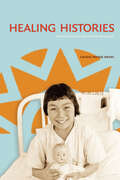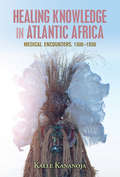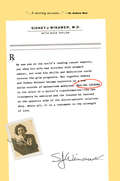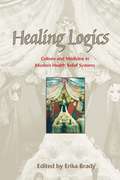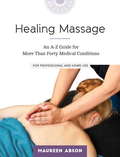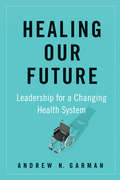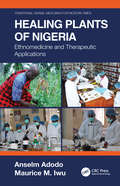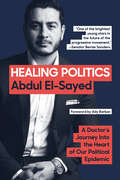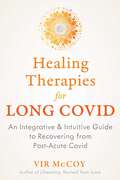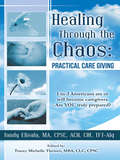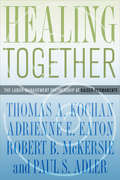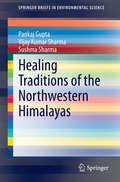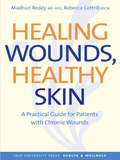- Table View
- List View
Healing Her Brooding Island Hero
by Marion LennoxHas this wounded doc…met his match?Doctor Hugh Duncan might be determined to hide behind his scars on Sandpiper Island, but his new neighbor, nurse practitioner Gina, is having none of it. He&’s a doctor, and she needs his help to take care of the islanders. But Gina also understands how life-changing tragedy can be, and she wants to help mend this gorgeous hero&’s heart—even if that means losing her own to him in the process! &“This one is terrific and compelling. Not only because it's her 125th book, but because it's also a lovely romance with very special characters that touch your heart. A beautiful read.&”-Goodreads on Falling for His Island Nurse &“Pregnant Midwife on His Doorstep is a heartwarming romance…. Lennox has penned a very strong story that pulls you forward and leaves you with a great Happily Ever After.&”-Goodreads
Healing Her Emergency Doc
by Caroline AndersonHis runaway date is back……for good?When Laura and Tom find themselves competing for a job in Yoxburgh Park Hospital&’s ER, it&’s, well, awkward! Last time they met, Laura ran…before they could become more than friends. But with just one job on offer, what&’s the harm in giving in to temptation? They&’ll hardly be working together. Right? Wrong! And when Tom gets a life-changing diagnosis, can Laura convince Tom that she&’s ready to be by his side—always? &“An immensely talented writer who never fails to create likeable characters readers will instantly fall in love with, Tempted by the Single Mom is certainly no exception. A witty, poignant and heart-warming tale that will make readers smile….&”-Goodreads &“What a delightful story…. Overall, Ms. Anderson has delivered an emotionally-animating and entertaining read in this book…the romance was nicely-detailed….&”-Harlequin Junkie on From Heartache to Forever
Healing Herbal Teas: Learn to Blend 101 Specially Formulated Teas for Stress Management, Common Ailments, Seasonal Health, and Immune Support
by Sarah FarrFreshly blended herbal teas offer more healing power than do pre-packaged tea bags. In Healing Herbal Teas, master herbalist and author Sarah Farr serves up 101 original recipes that not only offer health advantages but also taste great. Formulations to benefit each body system and promote well-being include Daily Adrenal Support, Inflammation Reduction, and Digestive Tonic. Additional recipes that address seasonal needs such as allergy relief or immune support will attune you to the cycles of nature, while instruction on the art of tea blending will teach you how to develop your own signature mixtures to give your body exactly what it needs. This book is an enchanting and delectable guide to blending and brewing power-packed herbal teas at home.
Healing Histories: Stories from Canada's Indian Hospitals
by Laurie Meijer DreesA social history of tubercular hospitals and Canada’s indigenous population, built around “poignant and at times heartbreaking” firsthand accounts (Choice). Featuring oral accounts from patients, families, and workers who experienced Canada’s Indian Hospital system, Healing Histories presents a fresh perspective on health care history that includes the diverse voices and insights of the many people affected by tuberculosis and its treatment in the mid-twentieth century. This intercultural history models new methodologies and ethics for researching and writing about indigenous Canada based on indigenous understandings of “story” and its critical role in Aboriginal historicity, while moving beyond routine colonial interpretations of victimization, oppression, and cultural destruction. Written for both academic and popular reading audiences, Healing Histories, the first detailed collection of Aboriginal perspectives on the history of tuberculosis in Canada’s indigenous communities and on the federal government’s Indian Health Services, is essential reading for those interested in Canadian Aboriginal history, the history of medicine and nursing, and oral history.
Healing Hormones
by Mark James Estren Beverly A. PotterHealing Hormones tackles a huge, attention-getting subject. TV and radio shows, websites telling people to take it easy, slow down, de-stress to feel better, live longer, be a better parent and more loving mate. But how? The prescriptions are disappointing: Yoga? Time-consuming and difficult for many. Prescription drugs? Costly, subject to abuse and may not be helpful. Naturopathic remedies? Unproven, untested and often ineffective.Healing Hormones has a better answer: show readers how to harness their own bodies' heal producing chemicals to improve their lives. Healing Hormones takes the take-care-of-yourself trend a step beyond where it has been before. Author Mark J. Estren, Ph.D., investigates five body-produced hormones that counter the stress response to make life better, calmer and more relaxed. The five healing hormones are dopamine, nitric oxide, endorphins, oxytocin, and serotonin.Healing Hormones will be readers' top choice to learn the pluses and minuses of the remarkable hormones that drive their health and happiness or undercut it. Estren-who has more than 20 years of experience writing about medical issues and research for patients and their families-explains how to harness the power of these healing hormones in clear, easily understandable language.
Healing Knowledge in Atlantic Africa: Medical Encounters, 1500–1850 (Global Health Histories)
by Kalle KananojaIn this ambitious analysis of medical encounters in Central and West Africa during the era of the Atlantic slave trade, Kalle Kananoja focuses on African and European perceptions of health, disease and healing. Arguing that the period was characterised by continuous knowledge exchange, he shows that indigenous natural medicine was used by locals and non-Africans alike. The mobility and circulation of healing techniques and materials was an important feature of the early modern Black Atlantic world. African healing specialists not only crossed the Atlantic to the Americas, but also moved within and between African regions to offer their services. At times, patients, Europeans included, travelled relatively long distances in Africa to receive treatment. Highlighting cross-cultural medical exchanges, Kananoja shows that local African knowledge was central to shaping responses to illness, providing a fresh, global perspective on African medicine and vernacular science in the early modern world.
Healing Lessons
by Sidney J WinawerDr. Sidney J. Winawer was one of the world's leading cancer experts. Yet when his wife Andrea was stricken with stomach cancer, not even his skills and dedication as a physician could reverse the grim prognosis. Together the couple explored complementary and alternative treatments. Healing Lessons is a testament to the strength of love and the story of a doctor's transformation--the new treatments he embraced and the lessons he learned on the opposite side of the doctor-patient relationship.
Healing Logics: Culture and Medicine in Modern Health Belief Systems
by Erika BradyScholars in folklore and anthropology are more directly involved in various aspects of medicine—such as medical education, clinical pastoral care, and negotiation of transcultural issues—than ever before. Old models of investigation that artificially isolated "folk medicine," "complementary and alternative medicine," and "biomedicine" as mutually exclusive have proven too limited in exploring the real-life complexities of health belief systems as they observably exist and are applied by contemporary Americans. Recent research strongly suggests that individuals construct their health belief systmes from diverse sources of authority, including community and ethnic tradition, education, spiritual beliefs, personal experience, the influence of popular media, and perception of the goals and means of formal medicine. Healing Logics explores the diversity of these belief systems and how they interact—in competing, conflicting, and sometimes remarkably congruent ways. This book contains essays by leading scholars in the field and a comprehensive bibliography of folklore and medicine.
Healing Lyme Disease Naturally
by Matthew Wood Andreas Thum Wolf D. StorlIn Healing Lyme Disease Naturally, anthropologist Wolf D. Storl shares his own success in overcoming a difficult, sometimes deadly disease that is reaching epidemic proportions. When he was diagnosed, Dr. Storl refused standard treatments because of antibiotic intolerance. Instead, he researched healing systems of various cultures including Traditional Chinese Medicine, American Indian healing practices, homeopathy, and traditional Western herbal lore and discovered the teasel root. Teasel, a flowering plant that grows throughout Europe and Asia, tonifies the liver and kidneys, promotes blood circulation, and strengthens the bones and tendons. The plant has been documented to help cure chronic conditions marked by arthritis, sore, stiff muscles, and eventual incapacitation--all symptoms associated with Lyme disease. Dr. Storl's approach consists of flushing out toxins and inhibiting bacteria by using teasel root as tincture, powder, or tea (available for purchase online and in natural foods stores); stimulating the immune system and detoxifying the body by exposing it to extreme heat (sweat lodges and Japanese baths); and dietary and naturopathic measures, including fresh natural food, exercise, and sufficient sleep. Written in an encouraging, personal tone but based in science and clinical studies, Healing Lyme Disease Naturally offers hope in combating a condition that has stubbornly resisted conventional medical treatment.From the Trade Paperback edition.
Healing Lyme: Natural Prevention and Treatment of Lyme Borreliosis and Its Coinfections
by Stephen Harrod BuhnerDespite Centers for Disease Control estimates that only 20,000 new Lyme disease infections occur each year, the true figure, as Harvard medical school researchers have found, nearly approaches 200,000. Symptoms run from mild lethargy to severe arthritis to incapacitating mental dysfunction. And despite medical pronouncements to the contrary, extensive research has found that tests for the disease are not very reliable and antibiotics are only partially effective; up to 35 percent of those infected will not respond to treatment or will relapse. The spirochetes that cause Lyme are stealth pathogens-they can hide within cells or alter their form so that antibiotics cannot affect them. Lyme disease is, in fact, a potent, emerging epidemic disease for which technological medicine is only partially effective. Healing Lyme examines the leading, scientific research on Lyme infection, its tests and treatments, and outlines the most potent herbal medicines and supplements that offer help-either alone or in combination with antibiotics-for preventing and healing the disease. It is the essential guide to Lyme infection and its treatment.
Healing Massage: For Professional and Home Use
by Maureen AbsonThis practical, detailed, and accessible guide to using massage to treat a range of medical conditions will educate and empower both massage practitioners and non-professionals who want to safely and effectively make a difference in the well-being of a friend or family member. Chapters are conveniently organized alphabetically, so that the reader can easily find helpful treatments for more than 40 medical conditions such as asthma, cancer, frozen shoulder, and plantar fasciitis. Bringing together Eastern and Western understandings of the body, health, and wellness, this user-friendly sourcebook defines and details each of the conditions, any contraindications to massage, and massage protocols and instructions, including how often treatment should be administered. Healing Massage can make treatment and pain relief both available and affordable to those who might not have access to expensive professional treatment. It can also provide substantial and detailed information to practitioners not familiar with a specific condition. Written by a leading massage practitioner and international teacher, this book will be a will be an essential reference in the office or at home.From the Trade Paperback edition.
Healing Our Future: Leadership for a Changing Health System
by Andy GarmanThis book is a practical, evidence-based guide to seven key leadership disciplines that will help anyone working in healthcare to pursue brighter futures.In this book, Andrew Garman looks at the major changes facing healthcare organizations and the leadership competencies required to successfully meet those challenges. He explains how people become more effective leaders over time and what science tells us works best in making this happen. At the heart of this book are seven universal disciplines—values, health system literacy, self-development, relations, execution, boundary-spanning, and transformation—which Garman divides into "enabling" and "action" disciplines. The enabling disciplines encompass the foundational work that makes leadership efforts more effective: learning more about ourselves, deepening our understanding of the world around us, and taking care of ourselves. The action disciplines describe leadership in the context of getting the work done: setting and resetting direction, collaborating inside and outside our organizations, anticipating what's coming, and helping people prepare for it. Collectively, they form an evidence-based common language of leadership that readers can easily map to any model that their organization or profession may already be using. Each chapter provides a description of the discipline, illustrates why it is important, and offers specific advice on how to raise proficiency. Appendixes offer step-by-step guidance on recruiting and engaging good mentors, along with input on developing long-term and foresight skills.
Healing Plants of Greek Myth: The Origins of Western Medicine and Its Original Plant Remedies Derived from Greek Myth
by Angela PaineGreek myth is part of our background, the names of many of the gods and goddesses known to us all. Within the myths are numerous references to plants used by goddesses and gods to heal or enchant, and the names of many of these plants have been incorporated into the Latin binomials that are used to identify them. By half a millennium BCE the physician god Asclepius entered into the mythology and temples were built to him called Asclepiaea, where the sick came to worship him and sleep with serpents in dormitories, hoping to experience miracle cures. At around the same time the first actual physicians began to practice within the Asclepiaea, using herbs, surgery and dietary advice. From these remote beginnings Greek medicine and botany evolved and were recorded, first in the Hypocratic Corpus, then by many other famous Greek physicians including Theophrastus, Dioscorides and Galen, who recorded the medicinal plants they used. This book traces the evolution of Greek medicine, the source of Western medicine, and looks at a selection of plants with healing properties, including a large number of trees which were both sacred and medicinal.
Healing Plants of Nigeria: Ethnomedicine and Therapeutic Applications (Traditional Herbal Medicines for Modern Times #15)
by Maurice M. Iwu Anselm AdodoHealing Plants of Nigeria: Ethnomedicine and Therapeutic Applications offers comprehensive information on the use of herbal medicines in West Africa. Combining an evidence-based, ethnobotanical perspective with a pharmacological and pharmaceutical approach to phytomedicine, the book bridges the gap between the study of herbal plants’ pharmacological properties and active compounds for the development of clinical drugs and community-oriented approaches, emphasising local use. It demonstrates how the framework of African traditional medicine can be preserved in a contemporary clinical context. The book outlines the history and beliefs surrounding the traditional use of herbs by the local population alongside their application in contemporary phytotherapy in Nigeria and West Africa. It features a critical assessment of the scientific rationale behind the use of these plants in ethnomedicine and offers a composite catalogue of phytotherapeutic and wellness agents, detailing the safety profile, efficacy, and scientific integrity of plants used to treat diseases and optimise health. Features: An ethnobotanical survey containing over 200 full-colour photographs of Nigerian and West African plants. A unique combination of ethnobotany and pharmacognosy, bridging the divide between pharmaceutical and community-oriented approaches to herbal medicine research. Contextual discussion of the therapeutic potential of Nigerian herbal medicine. Offers a template which can be used to separate the superstitious aspects of ethnomedicine from culturally inherited deposits of knowledge. A handbook for herbal and natural medicine practitioners, the book is aimed at African thinkers, scientists, healthcare providers and students of pharmacology and ethnomedicine.
Healing Politics: A Doctor's Journey into the Heart of Our Political Epidemic
by Abdul El-SayedA memoir about restoring the health of our people, and our democracy, from a physician and “one of the brightest young stars” of the progressive movement (Sen. Bernie Sanders).A child of immigrants, Abdul El-Sayed grew up feeling a responsibility to help others. He threw himself into the study of medicine and excelled—winning a Rhodes Scholarship, earning two advanced degrees, and landing a tenure-track position at Columbia University. At thirty, he became the youngest city health official in America, tasked with rebuilding Detroit’s health department after years of austerity policies. But El-Sayed found himself disillusioned. He could heal the sick—even build healthier, safer communities—but that wouldn’t address the social and economic conditions causing illness in the first place. So he left health for politics, running for Governor of Michigan and earning the support of progressive champions like Congresswoman Alexandria Ocasio-Cortez and Senator Bernie Sanders.This memoir traces the life of a young idealist, weaving together powerful personal stories and fascinating forays into history and science. Marrying his unique perspective with the science of epidemiology, El-Sayed diagnoses an underlying epidemic afflicting our country, an epidemic of insecurity. And to heal the rifts this epidemic has created, he lays out a new direction for the progressive movement. This is a bold, personal, and compellingly original book from a prominent young leader.“In Healing Politics, Abdul El-Sayed doesn’t just diagnose the causes of our broken politics; he gives us a prescription and treatment plan.” —Representative Pramila Jayapal
Healing Power of Minerals, Special Nutrients, and Trace Elements
by Paul BergnerYou can enjoy robust health without relying on a lowfat diet or bottles full of nutritional supplements. You don't even have to give up meat. The secret lies in The Healing Power of Minerals, Special Nutrients, and Trace Elements. From calcium and iron to the essential fatty acids and beyond, minerals are the hard-working dietary necessities that supply the body's building materials, affect digestion, and perform other tasks crucial to health and fitness. Modern farming and food processing rob food of valuable nutrients. But respected nutritionist, herbalist, and researcher Paul Bergner explains, item by item, how to restore 22 important minerals and other nutrients to your diet. You will learn how much of each you need and which foods and herbs can provide it. Find out just how easy and enjoyable good nutrition be! Includes image descriptions.
Healing Power of Play
by Eliana GilThis book describes how therapists can both facilitate constructive play therapy and intervene in posttraumatic play to help children who have been traumatized by abuse or neglect achieve a positive resolution. Traditional techniques of play therapy are reviewed for their application to this population. Throughout, numerous therapeutic aids are described to enhance the child's capacity to communicate verbally or symbolically. To help clinicians translate theory into daily practice, the book presents six detailed clinical vignettes that offer step-by-step guidelines for assessment and intervention in different situations of abuse or neglect.
Healing Smoothies for Cancer: Nutrition Support for Prevention and Recovery
by Daniella ChaceFight cancer and help prevent recurrence with these 100 delicious, research-based smoothie recipes!Over the last few years there has been a tremendous surge in research identifying the specific nutrients that have the ability to change the course of cancer. With a clearer understanding of the role that food nutrients, toxins, and microflora play in disease prevention and development, we have some of the long-sought answers to our questions about what triggers, promotes, heals, and prevents cancer. Chace offers medicinally-potent smoothie recipes that taste great and provide cancer protective and healing nutrients, such as:Banana Coconut Cocoa CreamBanana Ginger DreamBasil Berry CitrusCarotenoid CrushCherry Berry LimeCreamy Citrus BerryKumquat Berry CherryTangerine Currant CitrusWatermelon Blackberry and GingerAnd many more!The ingredients section of the book provides more than sixty cancer-healing foods that are perfect smoothie additions. Cancer patients and their care providers can use these smoothie recipes or create their own from the ingredients list to help heal and nourish the patient throughout the treatment process. In addition, many of the nutrients in these smoothies have been found to support remission and reduce the risk for cancer recurrence.
Healing Smoothies: 100 Research-Based, Delicious Recipes That Provide Nutrition Support for Cancer Prevention and Recovery
by Daniella Chace100 Research-Based, Delicious Recipes That Provide Nutrition Support for Prevention and Recovery Fight cancer and help prevent recurrence with these delicious smoothies! Over the last few years there has been a tremendous surge in research identifying the specific nutrients that have the ability to change the course of cancer. With a clearer understanding of the role that food nutrients, toxins, and microflora play in disease prevention and development, we have some of the long sought answers to our questions about what triggers, promotes, heals, and prevents cancer. Chace offers medicinally-potent smoothie recipes that taste great and provide cancer protective and healing nutrients, such as: Banana Coconut Cocoa Cream Banana Ginger Dream Basil Berry Citrus Carotenoid Crush Cherry Berry Lime Creamy Citrus Berry Kumquat Berry Cherry Tangerine Currant Citrus Watermelon Blackberry and Ginger And many more! The ingredients section of the book provides more than sixty cancer-healing foods that are perfect smoothie additions. Cancer patients and their care providers can use these smoothie recipes or create their own from the ingredients list to help heal and nourish the patient throughout the treatment process. In addition, many of the nutrients in these smoothies have been found to support remission and reduce the risk for cancer recurrence.
Healing Springs of Russia
by Dmitry Orlov Svetlana Malkhazova Natalia Shartova Sergey Starikov Tatiana PuzanovaThis book provides the first diverse and multifaceted textual and cartographic overview of natural curative resources of mineral waters and peloids in Russia.In a readily understandable way the book informs about the genesis, history of exploration and geographical features of water springs, their properties and use as healing springs, as well as specifics and prospect of their contemporary use. The monograph features numerous color illustrations and photos and is oriented toward a general audience but also appeals to geographers, environmental and public health workers and other specialists interested in environmental and public health issues.
Healing Therapies for Long Covid: An Integrative and Intuitive Guide to Recovering from Post-Acute Covid
by Vir McCoyDevelop your own unique healing protocol for Long Covid• Discusses how to deal with the symptoms of Long Covid, from brain fog and headaches to hormonal dysregulation, immune malfunction, and limbic system dysfunction, to histamine intolerance to certain foods and more• Presents medicines and methods ranging from pharmaceutical, herbal, and homeopathic remedies to breathwork practices, detox therapies, lymph drainage exercises, shamanic techniques, and neuroplasticity retraining• Explores techniques for accessing one&’s own intuition for remedies and how to combine them with modern medicineEarly in the pandemic, Vir McCoy contracted Covid-19, which developed into post-acute sequelae of Covid (PASC), commonly known as long Covid or long-haul Covid. As a medical intuitive and scientist he began collecting both intuitive information and extensive scientific and medical research about the nature of long-haul Covid. Integrating his intuitive impressions with other protocols and support group success stories, he developed this comprehensive healing guide for successful recovery options from long Covid.The author discusses the primary symptoms and predispositions of long Covid and outlines the basic steps for dealing with each of them, including brain fog, tinnitus, loss of smell and hair, debilitating headaches, hormonal dysregulation, immune malfunction, limbic system dysfunction, gut issues, mental instability, sleeplessness, and intolerance to certain foods. Backed up by more than 350 scientific references, he presents medicines and methods for healing long Covid, ranging from pharmaceutical, herbal, and homeopathic remedies to breathwork practices, detox therapies, lymph drainage exercises, gut biome restoration, neuroplasticity retraining, immune modulation, and shamanic techniques as well as meditations and mantras for calming the limbic system and the PTSD that can accompany chronic illness.Detailing the art of &“intuitive access,&” the author teaches how to discover your own unique remedies and presents a guide for incorporating these intuitive therapies with modern medical treatments and other healing strategies. He also explores the deeper significance of disease and how the &“disease&” may be teaching us something greater: a way to reclaim our power.
Healing Through the Chaos: Practical Care Giving
by Tandy ElisalaIf you have never been a caregiver, chances are you will become one. One in three people are or will become caregivers and most are unprepared. A devastating illness or an unexpected disabling injury can change your life in the blink of an eye. Part self-help and part memoir, Healing Through the Chaos takes an inside look into Tandy's unexpected journey from corporate executive and entrepreneur to full-time caregiver while raising three children as a single mother and simultaneously going through cancer for the third time. This book distills years of wisdom to give you invaluable and practical care giving strategies and an action guide you can use today. This book is for you if: * Saving time, money, stress, and heartache is important to you * You are taking care of a parent, grandparent, or other loved one * You are raising children while providing care for a parent * You anticipate making health care decisions for an aging or ill loved one * You want your wishes known and followed in the event of incapacitation You will learn: * Why your legal, medical and household affairs MUST be in order * Ways to improve communications with medical providers * How to keep loved ones safe; physically, emotionally, and financially * How to avoid mistakes from someone who has been there * The overlooked roles gratitude, humor and self-care play in care giving * Ways to create a legacy that honors your loved ones and much, much more This is a must read and valuable resource you will use time and time again.
Healing Together
by Thomas A. Kochan Adrienne E. Eaton Robert B. Mckersie Paul S. AdlerKaiser Permanente is the largest managed care organization in the country. It also happens to have the largest and most complex labor-management partnership ever created in the United States. This book tells the story of that partnership-how it started, how it grew, who made it happen, and the lessons to be learned from its successes and complications. With twenty-seven unions and an organization as complex as 8. 6-million-member Kaiser Permanente, establishing the partnership was not a simple task and maintaining it has proven to be extraordinarily challenging. Thomas A. Kochan, Adrienne E. Eaton, Robert B. McKersie, and Paul S. Adler are among a team of researchers who have been tracking the evolution of the partnership between Kaiser Permanente and the Coalition of Kaiser Permanente Unions ever since 2001. They review the history of health care labor relations and present a profile of Kaiser Permanente as it has developed over the years. They then delve into the partnership, discussing its achievements and struggles, including the negotiation of the most innovative collective bargaining agreements in the history of American labor relations. Healing Together concludes with an assessment of the Kaiser partnership's effect on the larger health care system and its implications for labor-management relations in other industries.
Healing Traditions of the Northwestern Himalayas
by Pankaj Gupta Vijay Kumar Sharma Sushma SharmaThis book discusses the perception of disease, healing concepts and the evolution of traditional systems of healing in the Himalayas of Himachal Pradesh, India. The chapters cover a diverse range issues: people and knowledge systems, healing in ancient scriptures, concept of sacredness and faith healing, food as medicament, presumptions about disease, ethno-botanical aspects of medicinal plants, collection and processing of herbs, traditional therapeutic procedures, indigenous Materia medica, etc. The book also discusses the diverse therapeutic procedures followed by Himalayan healers and their significance in the socio-cultural life of Himalayan societies. The World Health Organization defines traditional medicine as wisdom, skills, and practices based on theories, beliefs, and experiences indigenous to different cultures, used in the prevention, diagnosis, improvement or treatment of physical and mental illness and maintenance of health. In some Asian and African countries, 80% of the population depends on traditional medicine for primary health care. However, the knowledge of these conventional healing techniques and traditions associated with conveying this knowledge are slowly disappearing. The authors highlight the importance of safeguarding this indigenous knowledge in the cultural milieu of the Himachal Himalayas. This book will be an important resource for researchers in medical anthropology, biology, ethno-biology, ecology, community health, health behavior, psychotherapy, and Himalayan studies.
Healing Wounds, Healthy Skin
by Madhuri Reddy Rebecca CottrillSeven million Americans suffer from chronic or slow-healing wounds--this number includes people with diabetes, dementia, paralysis, spinal cord injury, multiple sclerosis, and poor circulation, as well as the elderly and those with reduced mobility. Healing Wounds, Healthy Skin provides patients and caregivers with everything they need to know on the subject, including: Why chronic wounds develop and who is at risk of developing them What "normal healing" is What the different types of wounds are, including those associated with chronic disease How to find appropriate care and get a correct diagnosis What role exercise and nutrition play in treatment and prevention What treatment options are available, from surgery to alternative therapies Also covered are the patients' psychological and emotional experiences, myths about wounds and wound healing, steps to take in an emergency, and a wound patient's bill of rights. With up-to-date information, insightful patient case histories, and a wealth of essential resources, this is the book that chronic wound patients and their caregivers can turn to with confidence.



